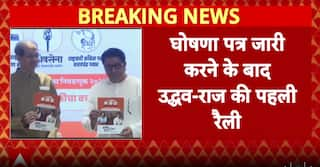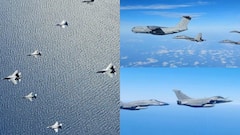India, Nepal Vow To Work Towards Opening More Air Routes, Resolve Boundary Dispute
Prime Minister Narendra Modi and Nepal’s Prime Minister Pushpa Kamal Dahal ‘Prachanda’ signed long-term energy deal that will allow Nepal to export power to Bangladesh through enhanced energy trade

After much discomfort expressed by Nepal, India has finally agreed to study Kathmandu’s proposal to open more air routes between the two countries during the bilateral meeting held between Prime Minister Narendra Modi and Nepal’s Prime Minister Pushpa Kamal Dahal ‘Prachanda’ on Thursday.
Both the Prime Ministers also discussed the boundary dispute during the bilateral meeting, including Nepal’s 2020 move to change their political map and include the disputed territories in it.
The opening of additional air routes was one of the main agenda items for PM Dahal’s visit to India.
“We discussed Nepal’s request for additional air entry routes. Nepal welcomes India’s positive indication of air-entry routes for bilateral flights. It is operationally feasible for ATR aircrafts. We request for approval of high-altitude additional air-entry route from Mahendranagar at an early date," the Maoist chief, who is on a four-day visit to India, said.
While Prime Minister Modi did not mention the enhancement of air connectivity explicitly in his address to the media, Foreign Secretary Vinay Kwatra said, the matter was discussed and India has decided to deploy a “technical team” to analyse the routes as it will entail opening up of India’s airspace for certain cities.
Nepal has been complaining that India has rendered their two new airports – Bhairahawa International Airport and Pokhara International Airport – profitless since New Delhi did not give its green signal to operate more flights from these airports to other Indian cities.
According to Kwatra, opening up for more air routes between India and Nepal is “a question of connectivity between different cities of Nepal and different cities of India and there is also an element of connectivity with different cities of Nepal through different air routes … The airspace are into the domains where it interferes into the space which is commanded by the Air Force.”
Despite several requests from Nepal, India refused to open more air routes because of the fact that the Pokhara airport has been built with the help of Chinese loans and Beijing has claimed it to be part of their Belt and Road Initiative (BRI). The Bhairahawa International Airport has also been built by a Chinese contractor, diplomatic sources told ABP Live.
The sources also said that operationalisation of these airports is crucial for Nepal’s economy since the two airports are designed to attract more tourists from India as well as China.
India, Nepal Ties To Get ‘Height Of The Himalayas’
Jointly addressing the media at Delhi’s Hyderabad House, Prime Minister Modi said both countries will work towards giving the bilateral relationship the “height of the Himalayas” referring to the Kalapani dispute.
“We will continue to work to give our relationship the height of the Himalayas. And in this spirit, we will solve all the issues, whether it is boundary or any other issue,” said Modi during a joint press conference after the meeting.
The matter also came up for discussion Wednesday when PM Dahal met National Security Advisor (NSA) Ajit Doval.
Dahal, who came to power in Nepal after much political haggling in December 2022 succeeding Sher Bahadur Deuba, left no stone unturned to showcase his trip as a major achievement.
Referring to the contentious issue of the border, he said, “Prime Minister Modiji and I discussed the boundary matters. I urged Prime Minister Modiji to resolve the boundary matters through the established bilateral diplomatic mechanisms,” said Dahal.
According to sources in the Nepal government, Dahal is keen to overturn the decision taken by the former PM of Nepal KPS Oli. Oli is a former ally but now an arch rival of Dahal.
It was under Oli’s rule that Nepal changed its political map by including the disputed areas of Lipulekh, Kalapani and Limpiyadhura within its territory. Oli was also able to get their Constitution amended by adopting the new map. Before this, India and Nepal had been following the Treaty of Sugauli (1816) and their own 1960 agreement when it came to the Kalapani border issue.
Nepal To Export Power To Bangladesh Using India’s Infrastructure
Both sides also signed an agreement Thursday that will enable Nepal to export power to Bangladesh using India’s transmission lines, in a further boost to ‘Neighbour First’ policy of New Delhi.
“I also appreciated India’s willingness to facilitate the export of hydropower from Nepal to Bangladesh through India. We have agreed that export of up to 50 MW of power from Nepal to Bangladesh via India would commence soon and the three countries would work out an agreement to this effect soon,” said Dahal.
In yet another significant move, India also allowed Nepal to access inland waterways for the first time in the history of the bilateral ties of these two countries. This is expected to further enhance trading ties between the two.
Both sides launched as many as six projects encompassing rail connectivity and also inaugurated Indian railway cargo train from Bathnaha (India) to Nepal Customs Yard which is the newly constructed rail link under Indian grant.
Both countries also threw open two integrated checkposts (ICPs) at Nepalgunj (Nepal) and Rupaidiha (India).
This is Prachanda’s fourth visit to India as the Prime Minister of Nepal. He came here in September 2008 and thereafter in September and October in 2018. He will be leaving for Madhya Pradesh Friday from where he will leave for Kathmandu Saturday.
Related Video
India@2047 Summit: Modi Calls for Innovation, Reforms, and National Resolve






































